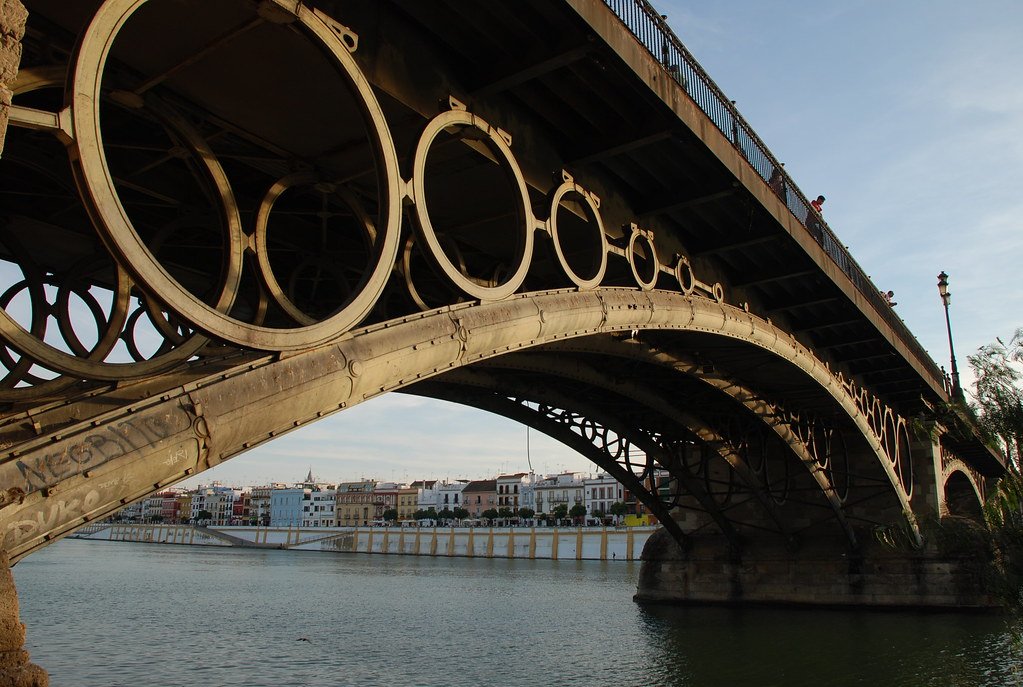
The Guadalquivir River crosses the city of Seville from north to south and there are a total of ten bridges connecting the city with characteristics that reflect the imprints left behind of the different cultures and customs that have existed in this historic city. Learn more about Seville bridge by bridge!
1.Pasarela de San Jeronimo
This pedestrian footbridge connects the Alamillo Park and the San Jeronimo Park to join both areas making its extension of 150 hectares the longest green area in all of Andalusia. The San Jeronimo pedestrian bridge is a total of 224 metres in length and from which visitors can observe a unique natural reserve, home to a variety of animals including such birds as coots, cormorants or ducks and even snakes or other larger nocturnal birds of prey.
2.Alamillo Bridge
The Alamillo was built in 1992 and designed by Santiago Calatrava. Currently, it allows for traffic flow towards the SE-30 roadway and connects the well-known “Via de La Plata” (the beginning of the pathway to the Camino de Santiago or the Way of Saint James). This area includes the northern area of Santiponce and Camas and the Island of Cartuja, the Olympic Stadium and the Alamillo Park. The bridge holds a unique pillar in diagonal that acts as a counterweight with three 200 metre long cables.
3.Barqueta Bridge
Also known as the Mapfre bridge, the Barqueta connects the area of the scientific buildings and the Isla Mágica waterpark with the Avenida de Torneo and the historic centre of Seville. This is a hanging bridge with a large steel arch, supported on both shores of the river. It was built for the World Expo held in Seville in 1992 and is based on the designs of the engineers Arenas de Pablo and Pantaleón Prieto.
4.Pasarela de la Cartuja
This is a modest bridge built under the condition that it would not alter the panoramic view of the Monastery of the Cartuja. Dated in 1992, the year the World Expo was held in Seville, the bridge began as a pedestrian footbridge that joined the city centre with the Island of Cartuja where the monastery was located. However, it is now also open to vehicles. It was designed by Fritz Leonhardt and Viñuela Rueda.
5.Cristo de la Expiración Bridge
The Bridge of Cristo del Cachorro, as it is commonly known, passes over the river to connect the Seville city centre with the Triana neighbourhood. It is considered the natural exit toward el Aljarafe, the city of Huelva and the community of Extremadura. Also built in 1992, this bridge eliminated the gap that existed in the Guadalquivir River at that area of the city. The Cristo de la Expiración Bridge was designed by Manzanares Japón and is specifically characterised for its white tarps that provide shade for the pedestrians that walk on it.
6.Isabel II Bridge
This is also known as the Triana Bridge as it connects the historic centre of the city with the Triana neighbourhood. It was built in the year 1852 from rock and iron designed by French engineers Gustave Steinacher and Ferdinand Bernadet. This is the oldest conserved iron bridge to date in Spain, in addition to being declared a national historic monument in 1976.
7.San Telmo Bridge
This bridge crosses the river from the Gardens of Cristina to the Plaza de Cuba and takes its name from the San Telmo Palace. Moreover, the San Telmo Bridge was constructed in 1931 under the supervision of the engineer José Eugenio Ribera. It is interesting to highlight that, at first, it was meant to be a mobile bridge to allow for boats to pass, but was modified in 1968 when the ships began to dock in the southern area of the river.
8.Los Remedios Bridge
Originally, this was called the Generalísimo Bridge in honour of General Francisco Franco, however, as democracy reached Spain it was renamed Los Remedios Bridge. Some wonderful city views can be seen from this bridge and from this spot, it is also possible to see popular sites such as the Cathedral, the Torre del Oro and the Maestranza (bull fighting ring). It connects the Paseo de Las Delicias and the Maria Luisa Park with the neighbourhood Los Remedios. It was designed by Fernández Casado in 1868 due to the need to join this part of the city that was beginning to grow considerably.
9.Delicias Bridge
Built in 1992 for the World Expo and designed by the engineers Fernández Troyano and Manterola Armisen, the Delicias Bridge substituted the Bridge of Alfonso XIII, which had been built for the previous World Expo. Because of its proximity to the port, it is a mobile bridge, which allows for ships to pass as they move along the river. The area of the port is called the Delicias Pier and is currently being reformed for docking large cruise ships and modernised with the installation of an aquarium to attract more tourism to the area.
10.Centennial Bridge
It was inaugurated in the 1992 World Expo and is a cable-stayed bridge, with two towers reaching 102 metres in altitude and a height of 45 metres above the river. The Centennial Bridge is, of those listed here, located most to the south and where the SE-30 roadway passes through, which makes it highly used by personal cars and large transport trucks.
